
2004 Pinamar
Images by John & Steph
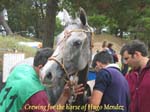
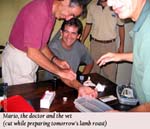
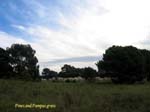
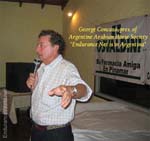
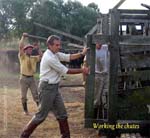
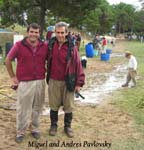


Schedule of Events || Venue || Riders || Starters
Results
Steph's Stories: Argentine Arabian Horse Society Endurance Ride || Life on the Pampas
Relaxed Anticipation || The Ride Part 1 || The Ride Part 2
Leonard's Story:
Argentina
Adventure
Life on the Pampas
 We returned to Miguel and Celinas estancia Sunday last afternoon. I
had spent the morning working on photos and checking my email at one
of the Internet Cafés in Pinamar. Miguel picked me up at the hotel and
we took a small tour of Pinamar, a very charming beach resort town,
and he showed me the various hotels and villas that were available so
I could report back to the USET folks in case they sent staff and
riders to the Pan Americans next year.
We returned to Miguel and Celinas estancia Sunday last afternoon. I
had spent the morning working on photos and checking my email at one
of the Internet Cafés in Pinamar. Miguel picked me up at the hotel and
we took a small tour of Pinamar, a very charming beach resort town,
and he showed me the various hotels and villas that were available so
I could report back to the USET folks in case they sent staff and
riders to the Pan Americans next year.
We coincidentally met a friend of Miguels - Alina (Lola) Gonzales Vidal (a trainer and rider who has been working in the Emirates) and Jason Kirk, the Australian trainer at the Abu Dhabi Equestrian Club. Jason was in Argentina looking at endurance horses, and after talking with Alina and Miguel he decided to come the next day to Miguels to look at his horses. Argentinean horses are becoming well known now in the Emirates, horses bred and sold by Los Estribos (Elena Romero Onata) recently placed 1st and 5th at the Presidents Cup, and 1st at another recent Emirates race - so Argentina is the new ´hot spot´for endurance horses. There are many buyers coming to look for both younger horses (5, 6 yrs) and horses that have competed well, especially at 160 km.
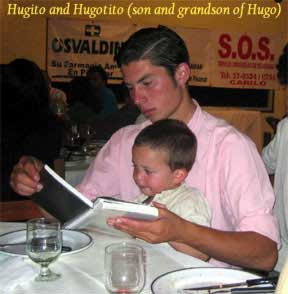 We had lunch at the small villa that they are staying at (belongs to a
friend), cleaned and packed the tack (wet) from yesterdays ride, and
drove the 150 km south to their estancia. Stopped at a grocery store
(Carrefour) in Mar del Plata, the large beach-side city south of
Buenos Aires, and arrived at the estancia early evening. Miguel gave
me a short tour of some of his horses (Its been a great challenge
trying to remember the names of his friends, family and
horses!). Miguel and Celina showed me their scrapbooks of photos and
articles of their horses and Miguels accomplishments. Three full
leather-bound books Miguel has spent his lifetime performing with
horses at the National and International level: driving, jumping,
3-day eventing, dressage, 'rodeo, and now Endurance. It was fun
seeing the photos of him and Celina in their youth, very handsome
Argentinean people.
We had lunch at the small villa that they are staying at (belongs to a
friend), cleaned and packed the tack (wet) from yesterdays ride, and
drove the 150 km south to their estancia. Stopped at a grocery store
(Carrefour) in Mar del Plata, the large beach-side city south of
Buenos Aires, and arrived at the estancia early evening. Miguel gave
me a short tour of some of his horses (Its been a great challenge
trying to remember the names of his friends, family and
horses!). Miguel and Celina showed me their scrapbooks of photos and
articles of their horses and Miguels accomplishments. Three full
leather-bound books Miguel has spent his lifetime performing with
horses at the National and International level: driving, jumping,
3-day eventing, dressage, 'rodeo, and now Endurance. It was fun
seeing the photos of him and Celina in their youth, very handsome
Argentinean people.
There are around 100 horses here at their estancia, mostly Arabians and Arabian crosses, but also ranch horses and driving horses (hackneys, saddle horses, Criollos). The Criollo is the South American version of our Mustang the native horse , which has been carefully bred over the years for consistency of size and color. They are stocky and fairly small (around 14 14.2) and are always dun, buckskin or palomino. They are coarse looking horses, but they are very popular and the main horse of the Gauchos. There are also performance requirements for the Criollo including an endurance test of around 40 km. But in Argentina only Arabians and Arabian crosses perform in the regulated sport of Endurance.
Monday was full of activity from early morning to late night. After breakfast Miguel met with his architect for a while and I worked on some of the billions of photos Ive been taking. While I was working Miguel came in and told me that we need to go and guide the fillies to their corral (in preparation for Jason Kirks visit). I hurriedly put my boots on and caught up with Miguel as he left for the road. As I caught up with him I heard a thundering, then looked across the fields to see around 30 horses at full gallop headed toward us.
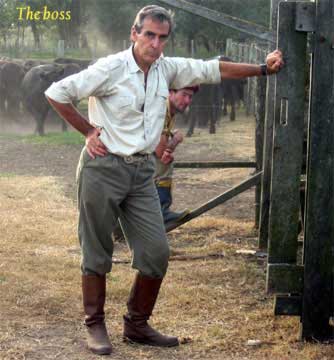 We were to stand at one of the gates to make sure they didnt go the
wrong way. Hugo (the estancia foreman, a Gaucho) was driving them from
behind. They veered off when they saw us, but then went the wrong
direction. Hugo raced after them, turning them once more. It was
beautiful to watch the dust, the manes and tails flying, the
thundering hooves, and the lone horseman behind them whooping and
twisting and turning quickly. (and no camera!) Finally the fillies
were corralled and we went over to see them. Such beautiful horses!
Consistently full-bodied, excellent bones, good round feet, and very
handsome heads and necks. I told Miguel I would be back with a ship
next time. Hugo and Celina joined us with the horses to look them
over. We looked at several other groups of horses too they all have
a similar look, a very good breeding program!
We were to stand at one of the gates to make sure they didnt go the
wrong way. Hugo (the estancia foreman, a Gaucho) was driving them from
behind. They veered off when they saw us, but then went the wrong
direction. Hugo raced after them, turning them once more. It was
beautiful to watch the dust, the manes and tails flying, the
thundering hooves, and the lone horseman behind them whooping and
twisting and turning quickly. (and no camera!) Finally the fillies
were corralled and we went over to see them. Such beautiful horses!
Consistently full-bodied, excellent bones, good round feet, and very
handsome heads and necks. I told Miguel I would be back with a ship
next time. Hugo and Celina joined us with the horses to look them
over. We looked at several other groups of horses too they all have
a similar look, a very good breeding program!
Afterwards I rode horseback with Miguel and Luli around the estancia. It is composed of the original ranch 'San Estaquio which belonged to Celinas grandfather, and a new acquisition 'La Pretendida del Moro giving them a total of around 1500 hectares. 100 horses, 500 head of cattle (heifers, steers, bulls), plus fields of wheat, sunflower, corn and soy. They work very hard at managing the land and maintaining top productivity.

The fields are continually rotated, old pastures replanted with new varieties of grass for higher productivity, channels and ditches to drain the wetter lowlands. There is a small river running through the estancia, which is filled with waterfowl. Miguel doesnt permit bird hunting here, so it is a refuge for the birds. There is also a large lagoon which was filled with various birds ducks, geese, storks, herons, flamingos (in summer) and a very large strange looking bird which is native to the pampas it looked like a cross between a goose, a vulture and a turkey, named after the sound it makes 'Chookah.
It was a very nice ride slowly wandering through the fields and along the river, the dog running in front chasing up the birds. Warm and sunny and relaxing. There is no such thing as 'open range here in central Argentina though. The entire property is fenced and cross-fenced and intensively managed. The animals and the crops have specific rotations to maintain optimum productivity. The crops are of the very best varieties, usually genetically engineered for highest yield. Miguel said that the use of pesticides is very high though, and much of the wildlife has declined, especially the jackrabbits and smaller mammals.
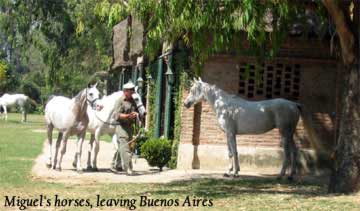
After the ride we returned to the house, and Jason and Alina arrived from Pinamar. We had barbeque (a common meal in Argentina) of ribs and chorizo (sausage) and various salads and then loaded into the truck for a tour of the horses. We looked at the young fillies and colts, the mares and foals and the stallions, all spread throughout the estancia in various fields. Jason is the trainer of both Arabians and Thoroughbreds in Abu Dhabi. It was interesting to see him examine the horses with his critical eye and listen to the conversations he had with Miguel (in English!) regarding breeding and training.
Miguel usually starts his horses at 3-4 years, does several small training sessions spread over a year or so, and then starts them in training and conditioning at 4-5 years. Most of his horses will do their first endurance rides at 5 years in short rides, with a relaxed pace. By 6 yrs they are competing a few rides per year at a more competitive pace, and by late 6 and 7 yrs they may do their first 160 km.
After looking at the last group (the fillies that we corralled in the morning) Miguel drove us over to where the cattle are worked. Jason and Alina followed in their truck so they could watch for a while and then return to look more at the horses. This was the day to examine the bred cows and determine which ones were pregnant. They herded them in small groups into an enclosure, then individually along the chute and into the stocks so that the veterinarian could palpate for pregnancy. They also sprayed the backs of the cows for flies as they worked their way through the chute.
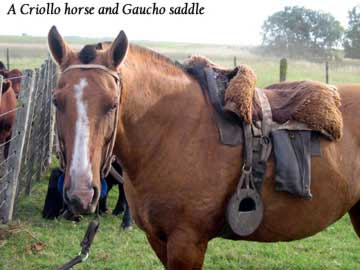 The pregnant cows were sent to one paddock, and the barren ones which
had either aborted or never conceived, were sent to another, to be
sold along with the steers for eventual processing. Those that were
confirmed pregnant would be sold to other ranchers. The price of
pregnant cows is high right now, and Miguel would be able to buy two
young heifers (unbred females) for the price of one bred cow, so this
would be a good business transaction. Miguel also raises high quality
bulls, so he can breed his cows to the best bloodlines and receive
good prices for the bred cows.
The pregnant cows were sent to one paddock, and the barren ones which
had either aborted or never conceived, were sent to another, to be
sold along with the steers for eventual processing. Those that were
confirmed pregnant would be sold to other ranchers. The price of
pregnant cows is high right now, and Miguel would be able to buy two
young heifers (unbred females) for the price of one bred cow, so this
would be a good business transaction. Miguel also raises high quality
bulls, so he can breed his cows to the best bloodlines and receive
good prices for the bred cows.
It was exciting watching the men work the cows fast, efficient, dusty, noisy moving them as quickly as possible. I tried to stay out of the way to watch and take pictures, but by the end of the day I was helping with gates and chasing the cows along through the chutes. Dusty and dirty and great fun! Ive had some good adventures with ranchers and cattlemen(/women) - staying a week several years ago at Fort Howes (Montana) to help/hinder Jan and Bill Stevens with vaccinations and castrations, riding the Owyhee Mountains with the local rancher Rohl Hipwell to gather and oversee his cattle. I love it should have been a cowboy.
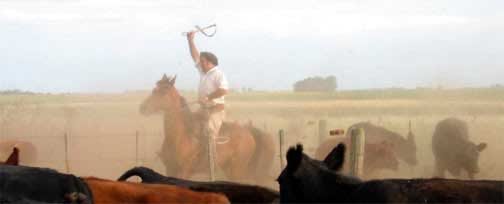 It was dark by the time they were finished with the last cows and we
went back to the house, and had a nice dinner prepared by Lucia, the
wife of Hugo, who runs the estancia. A lot of sun, riding and working,
a hot bath and a little red wine and I was as happy as a clam!
After dinner we watched a video that I had brought from Idaho. "The
Highly Exalted with Dean Tobias". This is a video/documentary of
a few weeks in northern Nevada, trailing cattle and an 8-horse team
chuck wagon from the range to the Owyhee River. Its a story of the
cowboy, the culture, the lifestyle, and the reality. I think Miguels
family enjoyed it; there are so many parallels with the Gauchos.
It was dark by the time they were finished with the last cows and we
went back to the house, and had a nice dinner prepared by Lucia, the
wife of Hugo, who runs the estancia. A lot of sun, riding and working,
a hot bath and a little red wine and I was as happy as a clam!
After dinner we watched a video that I had brought from Idaho. "The
Highly Exalted with Dean Tobias". This is a video/documentary of
a few weeks in northern Nevada, trailing cattle and an 8-horse team
chuck wagon from the range to the Owyhee River. Its a story of the
cowboy, the culture, the lifestyle, and the reality. I think Miguels
family enjoyed it; there are so many parallels with the Gauchos.
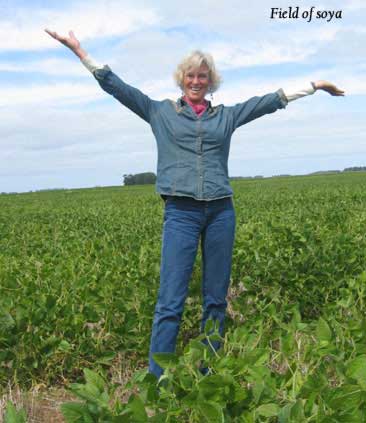 This afternoon we leave again for Pinamar to check on the horses,
and start making preparations for next weeks race. Miguels estancia
will have 13 horses entered. He and Luli plan to do the 160 km (FEI),
a few others will do the 120 km, and I will ride the 80 km along with
Hugo and Miguels son (also named Miguel (and also a hematologist)
but called 'Maiko - I think, I havent met him yet).
This afternoon we leave again for Pinamar to check on the horses,
and start making preparations for next weeks race. Miguels estancia
will have 13 horses entered. He and Luli plan to do the 160 km (FEI),
a few others will do the 120 km, and I will ride the 80 km along with
Hugo and Miguels son (also named Miguel (and also a hematologist)
but called 'Maiko - I think, I havent met him yet).
It should be a pleasant ride for us, no pressure to compete, just to finish. It will be more serious for Miguel and Luli as this will be part of the pdemonstration for the team to compete at the WEC in Dubai. So many horses! And there will be many people helping the 'team Moro I hope Im not too much of a difficulty with my limited Spanish.
Hasta luego,
Steph




